In a few months, I’ll be back in Nevada, tackling the Amargosa Playa again. This time I want to do a set of painted panels, five 5×5 foot ones (25 horizontal feet). I have various notions of how this might work out in paint, but will have to wait until I get there to see what actually happens. I also want to do something similar in textiles, perhaps only some preliminary image making, saving stitching for when I return to Portland. But I am mulling over both projects in my mind, trying to think how I might work them.
I just read a blog entry (dated August 17) by Jenny Bowker, who is an art colleague who works in quilted textiles. She tackled the same kind of landscape and had the same kind of hopes about what she might evoke, with some additions that the Amargosa doesn’t have: the presence of a handsome driver and some marvelous land forms. Her blog entry, which finishes with the photo of her textile work, is worth reading for sheer pleasure. But it makes me somewhat nervous about my ambitions.
Here’s the photo of Jenny’s artwork, which won a prize at the Canberra quilt exhibit and, I’m sure, will be seen often at other places around the globe.
Jenny Bowker, Sandstorm over the White Desert, about life size (see her blog entry for scale)
And here is an photo or two of what I will be facing, again
As I said, my desert has no handsome male to feature (although I might dredge one up in Beatty who would fill the bill.) But what I want to project is not so much the beautiful (although I find the Nevada desert is that) nor the humanity (found that appealing too), but the sheer power of the space, with each of its plants having a room of its own, and each fence post and road being a distinct presence:
I have the conundrum (I do love conundrums) of wanting to evoke the sense of space by using space, in this case, using a fairly tall (5 feet) and very long, horizontal canvas, filled. But filled how, with what — what will convey this space without sending the viewer into yawns of despair. (An aside: if you’ve ever driven Nevada over Highway 50, the loneliest highway in the US so-called, you know about yawns of despair).
I would like the painting to require the viewer to walk past it slowly, never quite being able to hold it in her vision all at once. I wouldn’t even mind a taller version, but fear I can’t handle anything over 5 feet tall. For one thing, we have to get back to Portland after a month, so the canvases will have to roll and fit into the Honda. But beyond that, I’m not sure I have the strength to carry off anything much bigger.
A textile piece that I’m envisioning would be smaller, I think, more like 1 foot by 5 feet. Still the 1 to 5 ratio, which I think may be about right. It would still require some movement on the part of the viewer’s head, if not the body, to take in the whole.
And of course, I will be thinking about Rackstraw Downes and various questions of perspective as I work up the painting and textile piece, trying to do work that is fresh to the eye and true to my seeing. There are human artifacts on the Amargosa, including a large talus pile and pond, roads and tracks, and fence posts and telephone poles, many no longer in use. So the vastness of the space has some human presence, but mostly marked by what was there but is no longer. Even the gold mine that made the talus slope is long gone.
What is there that is thrilling is the light that changes from minute to minute, changing what the eye can make out as well as the colors of land forms and hunks of bushes (the red car in the photo above is our Honda, coming toward the Barn studio, with the talus slope in the background.)
I’m hoping the conundrums will sort themselves out when I’m on site. Maybe they will — or maybe I’ll change my puzzles.
Have you faced difficulties of wanting to evoke something that might not be in your power to manage, but refusing to give in to the easier ways? I’m always fighting my stubborn ambition which can come up against unflinching reality. In which case, I give way. But not without a great fuss.
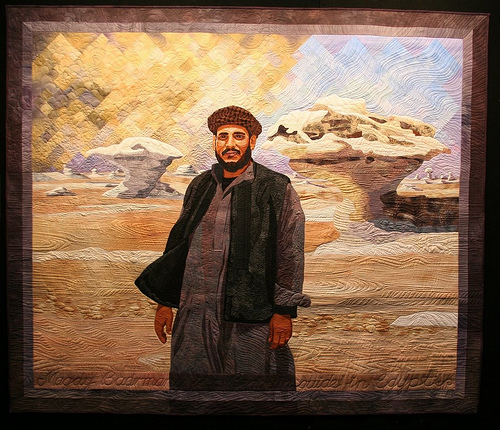

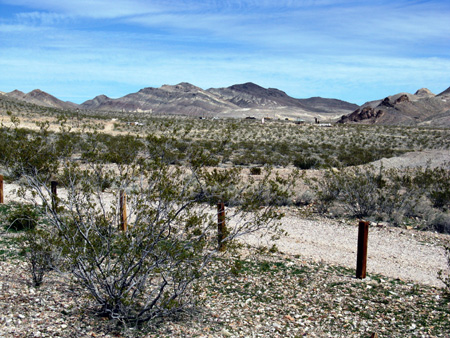
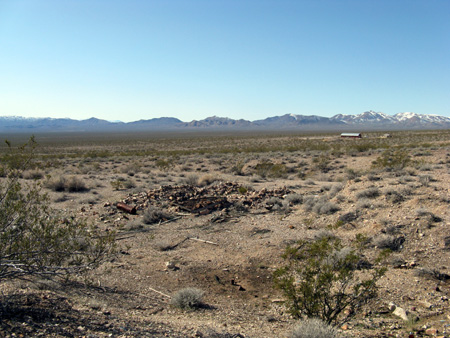
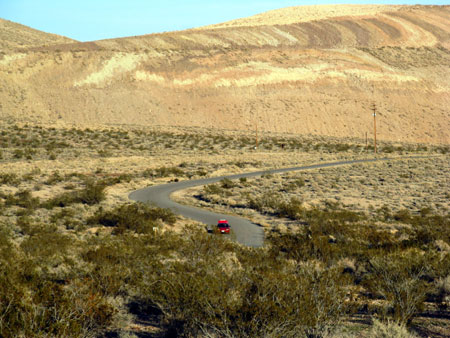
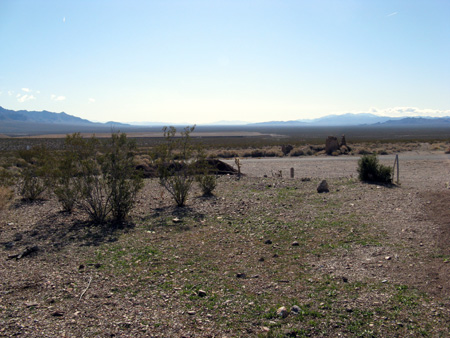


June:
Sounds logistical. Sounds profoundly ambitious. Sounds like a good idea withal. Good looking and good painting!
Go for the ambition! At the very least you will have a tremendous time looking.
Have you heard about David Hockney’s latest experiments with plein air painting? He puts canvasses side by side to paint from nature. I just love the huge results – and they do have the effect when you walk past them that one is there in the largeness of it all.
Here is an article about the biggest work that was exhibited two years ago:
http://www.royalacademy.org.uk/ra-magazine/summer2007/features/
Olga:
June does not lack for ambition, and is happy, I’m sure, that she is not alone in this kind of enterprise.
Thank you Jay.
June, yes, I constantly face difficulties in wanting to evoke something that I believe to be beyond my capabilities, and the joy for me is in the inching forward (with some leaps and bounds). I’m afraid that I tend to roll over and compromise, or try to work within whatever constraints rather than make a fuss – I certainly envy you that. Anyway it’s your grand vision that has brought me out of my normal silent lurk.
Olga:
I have been asked to speak for June at this time. I will endeavor, mostly in vain, to respond as I imagine she might – but with a fraction of the eloquence.
In my capacity I therefore thank you for your kind and perceptive comments.
June is alive and well – no need to be overly concerned.
Bon Voyage et Bon Peinture!
HI all,
I am back again, from another all-too-brief visit to the southeastern quadrant of Oregon, just north of where the range-and-basin land pushes into Oregon.
Jay, thanks for holding down the pages ’til I got back. I’m glad they didn’t blow around too much.
And Olga, the link to the article on Hockney is wonderful. Thank you very much. I did not know he was working so large — 40 x 15 feet! makes my project look small indeed. I am so glad to see that kind of work being done and I’ll go looking for more of Hockney’s recent efforts. It heartens me that he’s even older than I am and still struggling with things too big to be contemplated.
I had a good session in southeast Oregon, working on 7 aligned panels of 12 x 16″ each (horizontally lined up) to see what kinds of problems I would face doing larger work. I made some discoveries and was actually quite pleased with the immediate results, too. I told the instructor at the 3-day workshop that my agenda was to prepare for the larger Nevada project, so his comments were often aimed at helping me think in those terms. Now I’m planning to do one 5 x 5 canvas of something I can see from my Portland studio, to see what size brushes and how much paint and what kind of palette I’m going to need. Undoubtedly you’ll all hear much about this process once I’ve unpacked.
Olga, don’t roll over too many time nor work within too many constraints. It’s amazing what a little fuss can accomplish. Your work deserves all you want to give it — you do amazing things and if there’s more you can imagine, go for it!
Incidentally, Olga’s blog and her writing for raggedclothcafe are well worth following. Thanks, Olga, for those inspirations, too. I didn’t have internet access in eastern Oregon, but I’ll be checking in there soon.
Birgit, I’m going to comment on your waves just as soon as I catch my breath.
It’s good to be back, but the Oregon high desert is certainly wondrous.